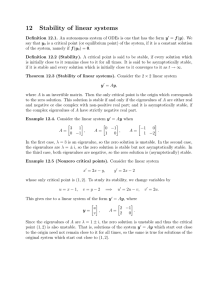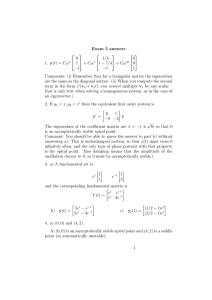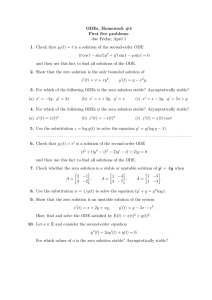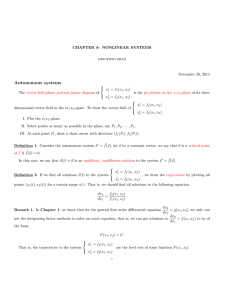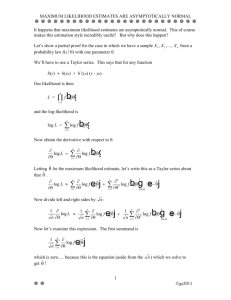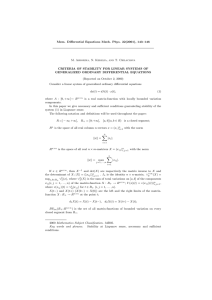ODEs, Homework #5 Solutions 1. −
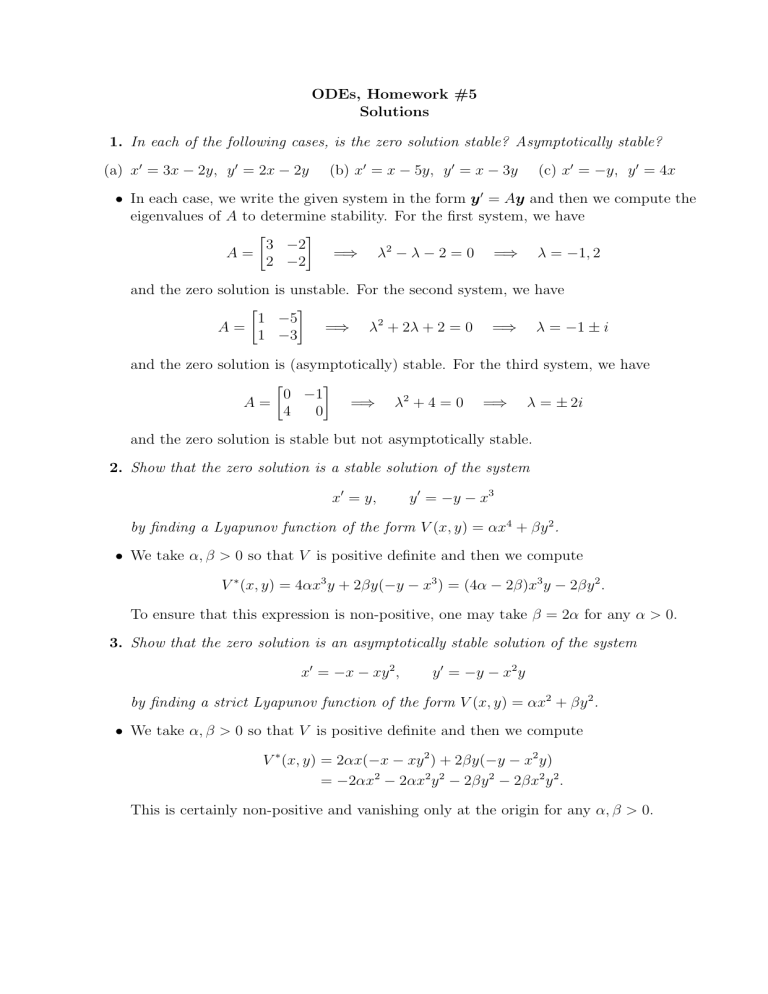
ODEs, Homework #5
Solutions
1.
In each of the following cases, is the zero solution stable? Asymptotically stable?
(a) x
′
= 3 x
−
2 y, y
′
= 2 x
−
2 y (b) x
′
= x
−
5 y, y
′
= x
−
3 y (c) x
′
=
− y, y
′
= 4 x
•
In each case, we write the given system in the form y
′
= A y and then we compute the eigenvalues of A to determine stability. For the first system, we have
A =
[
3
−
2
2
−
2
]
=
⇒
λ
2 −
λ
−
2 = 0 =
⇒
λ =
−
1 , 2 and the zero solution is unstable. For the second system, we have
A =
[
1
−
5
1
−
3
]
=
⇒
λ
2
+ 2 λ + 2 = 0 =
⇒
λ =
−
1
± i and the zero solution is (asymptotically) stable. For the third system, we have
A =
[
0
−
1
]
4 0
=
⇒
λ
2
+ 4 = 0 =
⇒
λ =
±
2 i and the zero solution is stable but not asymptotically stable.
2.
Show that the zero solution is a stable solution of the system x
′
= y, y
′
=
− y
− x
3 by finding a Lyapunov function of the form V ( x, y ) = αx 4 + βy 2 .
•
We take α, β > 0 so that V is positive definite and then we compute
V
∗
( x, y ) = 4 αx
3 y + 2 βy (
− y
− x
3
) = (4 α
−
2 β ) x
3 y
−
2 βy
2
.
To ensure that this expression is non-positive, one may take β = 2 α for any α > 0.
3.
Show that the zero solution is an asymptotically stable solution of the system x
′
=
− x
− xy
2
, y
′
=
− y
− x
2 y by finding a strict Lyapunov function of the form V ( x, y ) = αx 2 + βy 2 .
•
We take α, β > 0 so that V is positive definite and then we compute
V
∗
( x, y ) = 2 αx (
− x
− xy
2
) + 2 βy (
− y
− x
2 y )
=
−
2 αx
2 −
2 αx
2 y
2 −
2 βy
2 −
2 βx
2 y
2
.
This is certainly non-positive and vanishing only at the origin for any α, β > 0.
4.
Find all critical points of the system x
′
= x (10
− x
− y ) , y
′
= y (30
−
2 x
− y ) and then classify them as stable, asymptotically stable or unstable.
•
To find the critical points, we need to solve the equations x (10
− x
− y ) = 0 , y (30
−
2 x
− y ) = 0 .
These imply x = 0 and y (30
− y ) = 0 or else y = 0 and x (10
− x ) = 0 or else
10
− x
− y = 0 , 30
−
2 x
− y = 0 .
It now easily follows that there are four critical points, namely
A (0 , 0) , B (0 , 30) , C (10 , 0) , D (20 ,
−
10) .
To determine their stability, we compute the eigenvalues of the Jacobian matrix
J =
[ f x g x f g y y
]
=
[
10
−
2 x
− y
−
2 y
− x
30
−
2 x
−
2 y
]
.
At the point A (0 , 0), this becomes a diagonal matrix with entries 10 , 30 so the eigenvalues are positive and (0 , 0) is unstable. At the point B (0 , 30), we have
J =
[
−
20 0
−
60
−
30
]
=
⇒
λ =
−
20 ,
−
30 so this point is (asymptotically) stable. At the point C (10 , 0), we have
J =
[
−
10
−
10
]
0 10
=
⇒
λ =
−
10 , 10 so this point is unstable. At the point D (20 ,
−
10), we finally have
J =
[
−
20
−
20
]
20 10
=
⇒
λ
2
+ 10 λ + 200 = 0 =
⇒
λ =
−
5
±
5 i
√
7 so this point is (asymptotically) stable as well.
5.
Find all critical points of the system x
′
= y
2 − x, y
′
= x
2 − y and then classify them as stable, asymptotically stable or unstable.
•
A critical point ( x, y ) must satisfy the equations y
2
= x, x
2
= y =
⇒ y
4
= x
2
= y =
⇒ y ( y
3 −
1) = 0 .
Thus, it easily follows that the only critical points are
A (0 , 0) , B (1 , 1) .
To determine their stability, we compute the eigenvalues of the Jacobian matrix
J =
[ f x f g x g y y
]
=
[
−
1 2 y
2 x
−
1
]
.
At the point A (0 , 0), this becomes a diagonal matrix with entries
−
1 ,
−
1 so the zero solution is asymptotically stable. At the point B (1 , 1), we have
J =
[
−
1 2
2
−
1
]
=
⇒
λ
2
+ 2 λ
−
3 = 0 =
⇒
λ =
−
3 , 1 so one of the eigenvalues is positive and this point is unstable.


